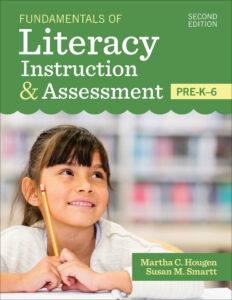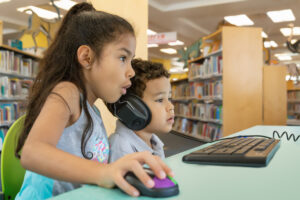7 Factors to Consider When Teaching English Learners
December 1, 2022
 Every school needs a carefully crafted plan for supporting students who are learning more than one language. In today’s blog post, you’ll review 7 important factors—and reflection questions—that school leaders and educators should consider when making a plan to support English learners (ELs). Excerpted and adapted from the book Fundamentals of Literacy Instruction & Assessment, Pre-K–6, Second Edition (edited by Martha C. Hougen, & Susan M. Smartt, with invited contributors), this is a helpful list to keep in mind when developing teaching strategies and supports for bilingual and multilingual learners.
Every school needs a carefully crafted plan for supporting students who are learning more than one language. In today’s blog post, you’ll review 7 important factors—and reflection questions—that school leaders and educators should consider when making a plan to support English learners (ELs). Excerpted and adapted from the book Fundamentals of Literacy Instruction & Assessment, Pre-K–6, Second Edition (edited by Martha C. Hougen, & Susan M. Smartt, with invited contributors), this is a helpful list to keep in mind when developing teaching strategies and supports for bilingual and multilingual learners.
Learning Environment
 Think about the location of the instruction, the classroom setting, educational materials, language program models, personnel available, and any other context for student learning. When reflecting on students’ learning environment, key questions to consider include:
Think about the location of the instruction, the classroom setting, educational materials, language program models, personnel available, and any other context for student learning. When reflecting on students’ learning environment, key questions to consider include:
- Do ELs have equitable conditions within the school as compared to their monolingual English- speaking peers?
- Are the instructional materials culturally and linguistically responsive? Can the students relate to the materials provided?
- Does your school have certified teachers who understand the specific needs of ELs?
- Do the classrooms have multilevel reading materials to support the growth of ELs’ content knowledge?
- Is the English language instruction of the highest quality? Does it include native language support when necessary?
- Are the teachers in your school exposed to sufficient professional development opportunities to deliver culturally relevant and linguistically responsive instruction?
Academic Achievement and Instructional Factors
 Review students’ level of performance and conduct an analysis of the instructional needs or modifications necessary for academic success. When reflecting on academic achievement and instructional factors, key questions to consider include:
Review students’ level of performance and conduct an analysis of the instructional needs or modifications necessary for academic success. When reflecting on academic achievement and instructional factors, key questions to consider include:
- Do the administrators and teachers in your school systematically evaluate and implement supports to improve ELs’ academic language and achievement?
- Does the staff determine ways to support the goals and increase comprehensible input of ELs? (Teachers increase students’ comprehensible input by using such things as visual aids and concrete objects.)
Oral Language and Literacy Factors

Consider the student’s native and second language opportunities within the academic and social settings. A review of the student’s language and literacy developmental history can also provide information that may be helpful for designing instruction. When reflecting on oral and literacy factors that may affect ELs’ academic success, key questions to consider include:
- What is the student’s current academic and social literacy level?
- Have instructional leaders determined and understood the student’s first or native language experiences? For example, do the caregivers speak primarily in the native language to the student?
- Are there opportunities for the student to listen to or speak in English? Has the student listened to books in their native language, second language (e.g., English), or both languages?
- What are the home literacy practices?
- What are the print experiences of the student at home or in the community?
- Are any developmental delays reported by the family?
- What are the student’s second language experiences?
- Has the student received continuous educational opportunities (e.g., continuity of services)?
- What opportunities exist for native language literacy?
- Does your literacy instruction address the five core areas of literacy instruction in the native and/or second language—phonemic awareness, phonics, fluency, vocabulary, and comprehension?
Personal and Family Factors

Personal and family factors that can affect student learning include the student’s home life, personal interests, socioeconomic status, and various supports. When reflecting on how a student’s home life may affect their literacy acquisition, key questions to consider include:
- What is the socioeconomic status of the student’s family?
- What are the family dynamics?
- Does the family have high expectations and aspirations for their child?
- Is parental engagement sufficient for the student’s academic achievement?
- What are the student’s interests?
- What is the student’s experiential background?
Physical and Psychological Factors

Consider the personal health and well-being of the student, as this may affect their response to instruction. When reflecting on how physical and psychological factors may influence a student’s literacy acquisition, key questions to consider include:
- What is the current and/or previous health of the student?
- Does the student have sufficient nutrition?
- Do any mental health issues exist?
- What is the student’s current social and emotional development?
- Does the student sense a strong feeling of belonging?
Previous Schooling Factors

Review the student’s academic history, including the language of previous instruction models. This information can help you determine the type of instruction that will be necessary for the student. When reflecting on what other schooling factors may affect an EL’s literacy acquisition, key questions to consider include:
- What formal and/or informal schooling opportunities has the student had access to?
- Was the instruction continuous or was it interrupted instruction?
- What was the language of the student’s previous instruction models? What is the current model?
- Did the previous school have a cohesive instructional program?
- Have teachers and administrators looked beyond the school records for more detailed information?
- Does the student have opportunities for instruction in all content areas?
Cross-Cultural Factors

Cross-cultural factors can include a feeling of belonging more to the home culture rather than the school culture, or vice versa. (Students may also feel a sense of belonging to both cultures.) Gathering this information can help educators become more sensitive to the emotional state of the student. When reflecting on cross-cultural factors, key questions to consider include:
- Are educators cognizant that ELs go through multicultural identities which can mean expressing loyalty, understanding, and attachment to more than one culture?
- What is the student’s home identity and/or school identity? Are the identities compatible?
- Do the adults in your school value diversity?
- Are we using cultural and linguistic differences as a resource?
Keep these 7 key factors in mind when designing instruction that helps English learners succeed in the classroom. And for guidance on supporting the reading and writing achievement of all pre-K–6 students, including those at risk for reading difficulties, pick up the book behind today’s post!
Fundamentals of Literacy Instruction & Assessment, Pre-K–6, Second Edition
 Edited by Martha C. Hougen, Ph.D., & Susan M. Smartt, Ph.D., with invited contributors
Edited by Martha C. Hougen, Ph.D., & Susan M. Smartt, Ph.D., with invited contributors
This essential text covers the research base for structured literacy instruction and practical guidance on the essential components of literacy instruction: oral language, phonemic awareness, phonics, vocabulary, fluency, comprehension, handwriting, spelling, and writing. Instructional activities, scripted demonstrations of lessons, and online resources give readers explicit examples of how to translate the research into classroom instruction.




Write a Comment
Your email address will not be published. Required fields are marked *
Post a Comment